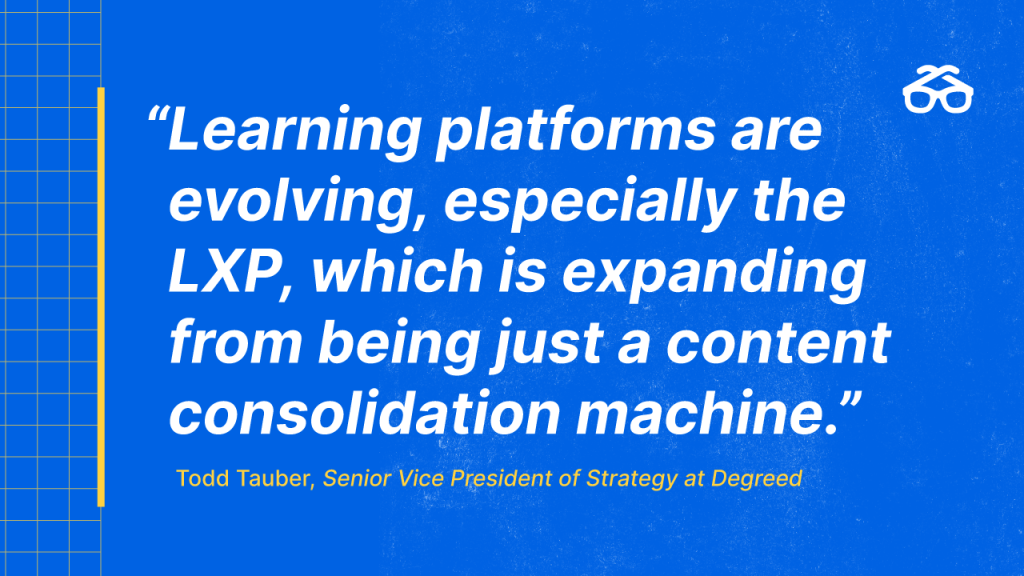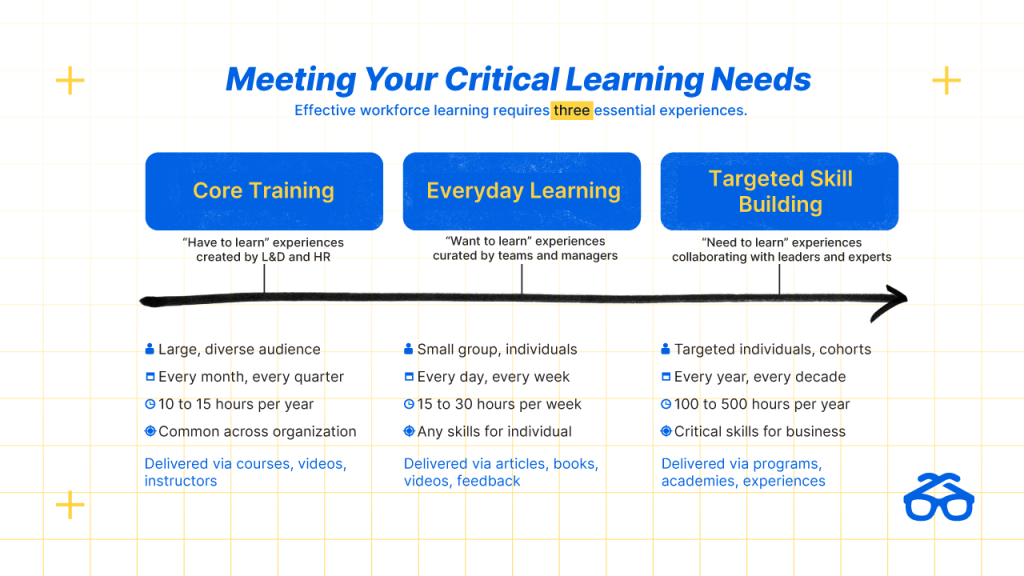Big challenges demand strategic solutions. As the new year unfolds, it’s a safe bet taxed learning teams from Boston to Bangkok are huddling and planning. They want to make sure they can deliver over the next 12 months.
At some point, those conversations will turn to technology, and likely to the merits of a learning experience platform (LXP): “Does it still have a place in our learning tech mix? Do we need one now if we never bought one 10 years ago? How is an LXP useful?”
For savvy L&D organizations, an LXP in 2024 is more critical than ever.
For learning teams, the past 12 months wrought the perfect storm, according to Todd Tauber, Senior Vice President of Strategy at Degreed. “They had to navigate an increasingly confusing learning technology market, with pressure from the C-Suite to create more business impact through learning, with tighter budgets.”
More and more, leaders want learning powered by data—to help deliver opportunities that grow skills their businesses need.
“Learning platforms are evolving, especially the LXP, which is expanding from being just a content consolidation machine to something that connects workforce intelligence and talent to internal marketplaces, HCM systems, and people analytics,” Todd said.

Weathering the Storm: Engagement, Support, Impact
Maybe your business needs to do a better job upskilling and reskilling by meeting your people where they’re at—with a lot less guesswork and better communication—so workers can learn what they need to when they need to and add more value.
Perhaps you’re looking to explore or fully embrace skill data—to identify skill gaps and deliver outcomes-focused learning to fill those gaps. And the moment your people raise their hands and say, “I’m ready for a new opportunity,” you want your learning team to know it’s true—and your company to be ready too.
If your organization is like others, you’re looking for better ways managers can build and lead world-class teams, uncover team skills, and optimize team strengths. You’d love a tool that facilitates this collaboration, a solution that continuously delivers the most relevant content mapped to strengths and weaknesses.
Maybe job readiness tops your to-do list. Wouldn’t it be great to easily provide your people curated pathways of videos, courses, podcasts, books, and more tailored to the immediate skill-building needs of their teams or departments?
If any of this rings true for you this new year, there’s a place for an LXP at your organization.
Big-Picture Goals: Building to Your LXP Moment
Learning tech is core to learning strategy. The forces and trends that make the LXP a great solution in 2024 reflect that. Let’s take a closer look:
- Learning in the flow of work. Engaging development that happens as needed during the workday is table stakes for any organization, according to Nehal Nangia, Research Director at The Josh Bersin Company. “By building the right learning experiences and developing critical future skills, learning organizations can help workers amplify their future growth potential. And, by illuminating pathways for workers to use those newly acquired skills and experiences to grow within the organization, they can help employees grow while building critical talent for their future needs.”
- Relevant, fast, and effective skill building. Old ways of predicting skill needs don’t work anymore. Business leaders need dynamic skills strategies, according to Gartner. This means understanding skill shifts as they’re occurring and developing skills at the time of need. It means creating employee-employer channels for sharing skill information, so employees can more accurately develop skills matched to what their organizations need.
- Upskilling at scale for digital transformation. The need for proficiency in digital technologies is massive, according to PWC. “Upskilling at scale is imperative to keeping businesses competitive, keeping societies stable, and providing a good livelihood for millions of people. And it starts with learning how to learn.”
- An ecosystem view. How your systems are designed can determine how well the combined elements of your learning tech stack work (or don’t work) together. It can determine how prepared your business is for challenges and change and how your organization works day to day. An open learning ecosystem can grow with your organization and connect tools you already use. As new challenges and opportunities arise, you can get access to new, innovative tools quickly and easily.

A Best-in-Class LXP: Intelligent Workforce Acceleration
A best-in-class LXP does a lot more than provide a front door to learning content, engage your people, and boost your learning culture. These are all hallmarks that helped drive the popularity of the LXP during the past decade, and they remain outstanding benefits. But today there’s even more to attain.
A top-tier LXP today unifies a company’s learning technology ecosystem, enabling L&D to provide people with highly personalized, always-on learning from any number of sources. In doing so, it gives learning and business leaders a wealth of data on people and their skills that can inform insightful and strategic business decisions.
What does that unification look like? A high-quality LXP can integrate your existing LMS, for example, as well as other learning and people solutions. Sitting at the top of your learning tech stack, the LXP boosts interactions, supports automations, and generates and visualizes learning insights based on core analytics. This enables learning leaders to reduce administrative overhead as they create the types of learning experiences essential to success in today’s economy. This consolidation can translate to cost savings, as L&D teams identify and eliminate learning content that isn’t being used.
In addition, a good LXP is designed to be adaptable at scale—to help self-directed employees search and quickly access content easily in the flow of work, whether they’re in the office or on the go. Likewise, a good LXP promotes social learning. It connects people through intuitive features and functions. At Degreed client PointClickCare, for example, learning leaders used skill data to match people interested in learning new capabilities with mentors. The Degreed Skill Coach tool, which supports collaboration between leaders and employees, helped drive those conversations.
Adding It All Up
For the employee, the LXP supports an experience in which learning and skill development is engaging, immediate, productive, and continuous.
For L&D, team members have a place where they can go get their jobs done more efficiently.
Take the Degreed platform, for instance. End users each have a homepage that’s unique, and they receive personalized learning recommendations based on their skills (for content, stretch assignments, mentorships, and more). The more personalized the learning recommendations are, the more relevant and impactful they are to each employee. This means learning teams using our LXP can deliver impactful learning (through personalized learning recommendations) at speed (automatically on the homepage without manual work from L&D) and at scale (to every employee with a Degreed profile).

Supporting Your C-Suite, Advancing Your Business
Meeting critical learning needs to support the C-suite and influence positive business outcomes—often on a tight, stagnant budget—is the core challenge learning teams face today. And, yes, the business units L&D partners with and serves often don’t want to pay for a solution but do want to steer how it’s used. All the while, L&D is accountable for coalescing, coordinating, and providing ongoing, cost-efficient support.
“Executing the CEO’s agenda almost always requires people within the organization to adopt new ways of seeing, thinking, and acting. Success requires learning at scale, with speed, in the places where it will matter most,” said James Fulton, Global Head of Talent and Chief Learning Officer at Goldman Sachs. “This is easier said than done.”
Meeting Critical Needs: More Diverse Learning
To get real value from employee development, companies today require three types of essential learning experiences—core training, everyday learning, and targeted skill building.
Core training can be thought of as the learning experiences your business has to deliver, like compliance training. Everyday learning empowers employees to grow in the ways they want to. And targeted skill building encompasses all the learning experiences your company needs to deliver to stay competitive.

A best–in-class LXP positively impacts all three critical learning experiences. Powered by data—and by unifying your learning tech—the LXP helps you know the skills your company needs, build the skills your workforce wants, and grow the skills your organization needs to meet business objectives.
Ready to learn more?
For a deeper dive into how an LXP can help people learn and a company thrive, download the new Degreed guide Why Buy an LXP?

